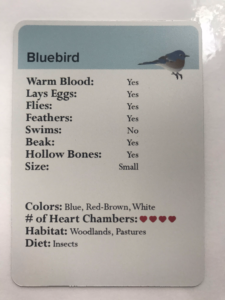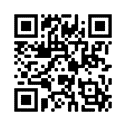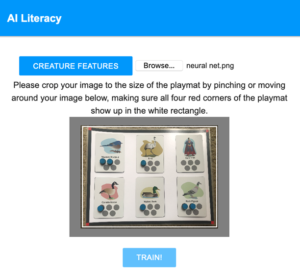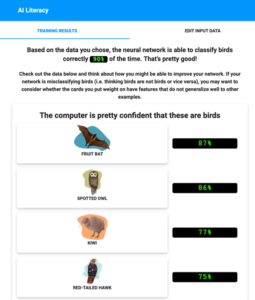In this activity, you will explore another type of AI—machine learning—which learns about concepts by looking at lots of different examples. The more examples of a certain type that the AI sees, the more emphasis/weight it puts on that type. For example, if you show the algorithm lots of images of large dogs, and not very many pictures of small or medium sized dogs, it might think that all dogs are large. Today you are going to explore how to create a dataset (a collection of examples) that can be used to train an algorithm to recognize birds.
Step 1: Build your training dataset
- In your box you will find a playmat, a card deck, and circular blue “weight” tokens.
- Deal out six cards onto the playmat. You can choose the cards or shuffle the deck and deal out random cards.
- Each card has a picture of a creature on the front and a list of features on the back. You can flip the cards over to look at the features on the back to help you complete the activity.


- The six cards you have dealt represent all of the data/examples you have to work with. You have to choose which examples are most important to help the algorithm classify birds by placing weight tokens on the cards.
- The more weight tokens you place on the cards, the more examples with that creature’s features are going to be input as training data to the algorithm. For example, if you put 3 tokens on a pelican and 2 tokens on an emu, your algorithm will be trained with 3 pelicans and 2 emus. The resulting algorithm might be really good at recognizing large birds but it might have a harder time recognizing small birds like sparrows, since you did not include any examples of those in your training data.
- Look at the features for each bird and try to consider how to place your weights to create an algorithm that can correctly recognize many different types of birds. You do not have to use all of the weight tokens.
Below is an example of a finished playmat:

Step 2: Test your network
- Make sure each card is placed bird-side-up inside of the rectangle on the playmat, and that the blue weight tokens are placed inside the designated circles on the cards.
- Take a picture of your playmat with a phone or tablet. Make sure the red corners of the playmat are visible in your picture, nothing is blocking the border on the playmat, and that the picture is rotated right-side-up—that helps the computer to recognize the image!
- Navigate to the link below by typing the link in your browser or taking a picture of the QR code (you can do this on a phone, computer, or tablet). Note that the character “l” in the URL is the letter “L” not the number “1”.
https://ailiteracyapps.lmc.gatech.edu/

- Once you have navigated to the website, click “Creature Features.”
- Click Browse and select the photo you took of your playmat.
- You will be prompted to crop your photo to the size of the playmat, making sure that the red corners of the mat are visible in the image.
- To move the image: drag with your finger (smartphone) or click and drag using your mouse or trackpad (computer).
- To resize the image: Use your fingers to pinch the image (smartphone) or use a scrolling motion on your mouse or trackpad (computer).
- Click “Train!” The next page might take a minute to load. The computer is testing how well your network is able to classify different inputs.

The app will show you how well your network classifies birds. Feel free to try again with different weights or different bird cards!

Discuss the following questions with your family:
- Which creatures did you end up putting your weights on and why?
- Were any birds particularly hard to get your AI to recognize? Why do you think these birds were difficult to recognize?
- Did any non-bird creatures get classified as birds by your AI? Why do you think this happened?
- Humans are in charge of selecting and providing the data that an AI algorithm learns from (like you did today!). Were you surprised at all by the role that people play in determining whether an AI algorithm works?
- Drawing on your experience today, can you think of any issues that might result from using machine learning in applications like recognizing faces or objects?